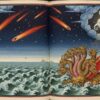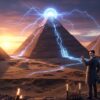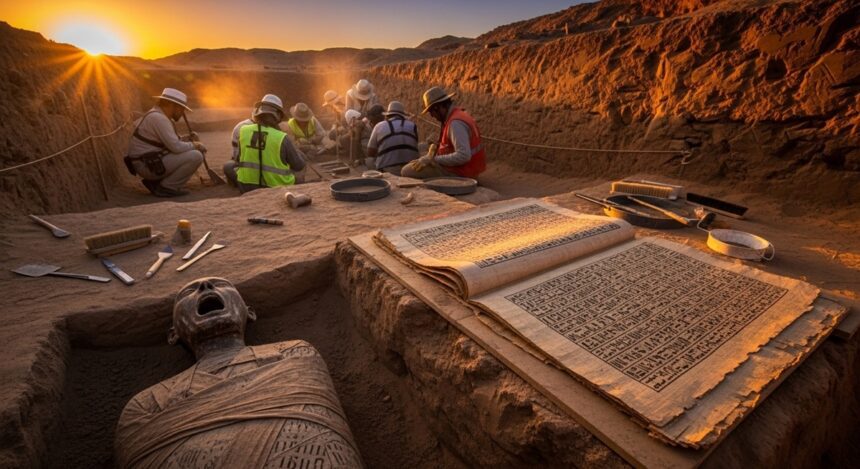Deep in the sands of Saqqara, where the ancient necropolis guards secrets older than history itself, archaeologists uncovered a chilling discovery—a 5,000-year-old manuscript that speaks not of the dead, but of humanity’s doom. This “Doomsday Manuscript,” as it’s been dubbed, is no ordinary relic. Written in both hieratic and hieroglyphic scripts, it delivers a cryptic warning from a long-lost civilization, one that seems to have foreseen a cycle of global catastrophes.
Accompanied by the eerie “Screaming Mummy,” this find has sent shockwaves through the scientific community, raising questions about humanity’s past, present, and precarious future. Could this ancient text hold the key to understanding our place in the cosmos—or is it a grim prophecy of our inevitable end?
A Message from the Realm of the Dead
Saqqara, a dusty village just south of Cairo, is far more than it appears. It’s a portal to the underworld, a sacred necropolis where Egypt’s elite—pharaohs, priests, and nobles—have rested for millennia. Home to 11 pyramids, including the iconic Step Pyramid of Djoser, Saqqara is steeped in the rituals of death and rebirth. The very name evokes Sokar, the falcon-headed deity of the dead, fertility, and the underworld, whose presence looms over the site like a shadow.
This is no place for the faint of heart. The necropolis is a labyrinth of tombs, catacombs, and buried secrets, each pyramid a silent testament to an ancient cult that revered the afterlife above all else. Yet, in 2025, archaeologists uncovered something that transcended even the grandeur of Saqqara’s past—a message from the realm of the dead that speaks directly to the living.
The Connection to Sokar
Sokar, often depicted as a mummified figure with a falcon’s head, was a deity of dualities—death and fertility, decay and renewal. His cult was central to Saqqara’s spiritual significance, and his name resonates with an almost otherworldly power. Some have even speculated about a curious linguistic parallel: rearrange the letters of “Oscar,” the name of the golden statuette awarded by the Academy of Motion Picture Arts and Sciences, and you get “Socar,” a near-anagram of Sokar. Is this mere coincidence, or does it hint at a deeper, esoteric connection? Occultists have long played with anagrams, seeing them as hidden codes in the fabric of reality. While the link may seem fanciful, it adds an intriguing layer to the mystery of Saqqara’s latest revelation.
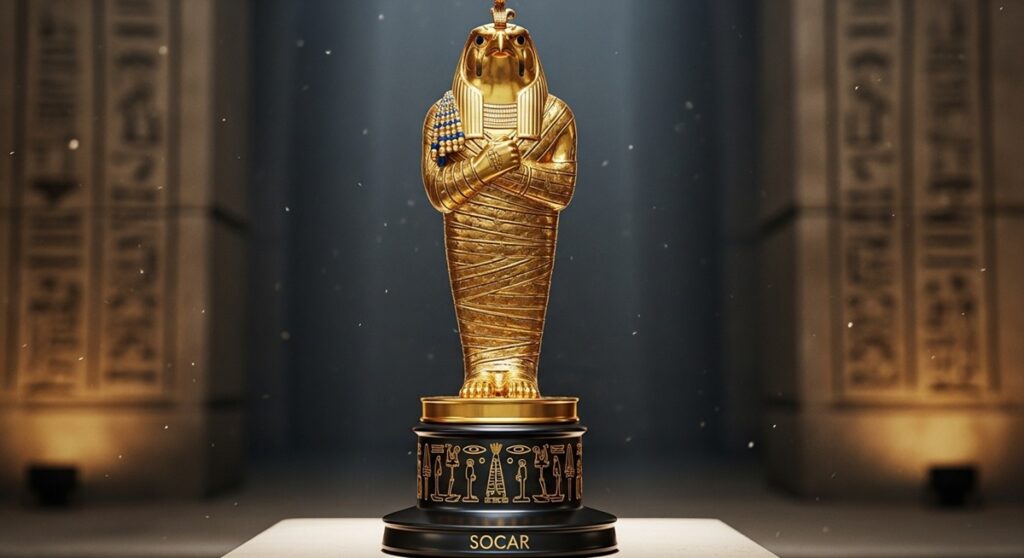
An Ancient Text Hidden in Darkness
Deep within the catacombs of Saqqara, archaeologists unsealed a sarcophagus expecting to find the usual trappings of an ancient burial—perhaps a funerary text or offerings for the afterlife. Instead, they uncovered a fragment of a manuscript unlike anything seen before. Written in two distinct scripts—hieratic, a cursive form of Egyptian writing, and the more formal hieroglyphs—this text was no ordinary record. It was a warning, etched in stone and papyrus, meant to endure for millennia.
Decoding the Unthinkable
The manuscript’s symbols were not easily deciphered. Many remain a puzzle, their meanings locked in the minds of a civilization long gone. To crack this ancient code, researchers turned to cutting-edge technology: artificial intelligence algorithms capable of analyzing patterns beyond human perception and advanced imaging techniques to reveal faded or hidden inscriptions. What they found was staggering.
Unlike typical Egyptian texts, which often recount the deeds of the deceased or guide them through the afterlife, this manuscript contained no mention of the individual buried with it. Instead, it described a series of global catastrophes—events so devastating they reshaped the world. Even more chilling, it predicted their return, warning that humanity is trapped in a cycle of destruction, doomed to repeat the same mistakes unless it heeds the wisdom of the past.
The Doomsday Manuscript: A Prophecy of Ruin
The core of the manuscript’s message is as unsettling as it is profound. It speaks of a world governed by invisible cosmic forces, where time itself is cyclical, looping through periods of creation and collapse. According to the text, humanity’s fate is not random but predetermined, a path where every immoral act—every betrayal of ancestral wisdom—pushes civilization closer to annihilation.
The Weight of Ancestral Wisdom
The author, whose identity remains unknown, warns that those who ignore the sacred knowledge of their ancestors will face “unspeakable horror” after death. This isn’t merely a moral admonition; it’s a cosmic indictment. The manuscript suggests that humanity’s survival depends on respecting the lessons of the past, lessons encoded in rituals, myths, and the very structure of the universe. To turn away is to invite not just personal ruin, but the collapse of all civilization.
Echoes of the Book of Enoch?
Some scholars have drawn parallels between the Saqqara manuscript and the Book of Enoch, an ancient text attributed to the biblical figure Enoch, which describes the creation of the world, the fall of angels, and the Last Judgment. Like the Book of Enoch, the Doomsday Manuscript seems to grapple with existential questions about humanity’s place in the cosmos. However, the Egyptian text predates known versions of Enoch’s writings, potentially making it a precursor—or even a source—for later apocalyptic traditions. Its focus on cyclical time and cosmic forces sets it apart, suggesting a worldview that is both older and more complex than previously understood.
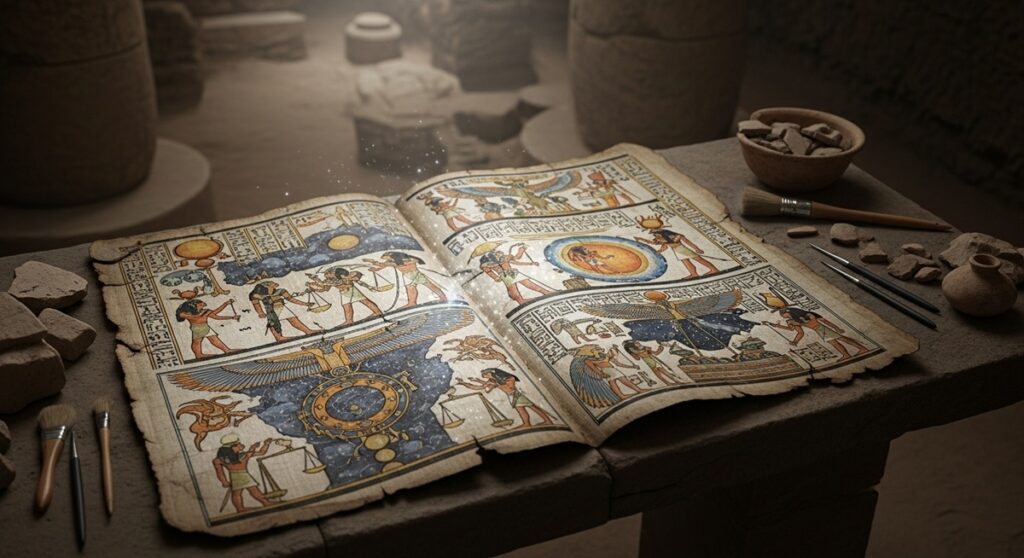
The Time Conjuring: A Cyclical Cosmos
At the heart of the manuscript lies a radical concept: time is not linear but cyclical, a repeating pattern where humanity rises, falls, and rises again, each cycle bringing it closer to an inevitable reckoning. The ancient Egyptians, known for their sophisticated understanding of astronomy and mathematics, believed the universe operated under immutable laws. The Doomsday Manuscript takes this further, positing that these laws dictate not just the movement of stars but the fate of civilizations.
Invisible Forces and Human Destiny
The text describes “invisible cosmic forces” that govern existence, forces that humanity ignores at its peril. These forces are not gods in the traditional sense but something more abstract—perhaps the fundamental principles of reality itself. The manuscript warns that humanity’s failure to align with these forces, through wisdom and moral conduct, will trigger catastrophic consequences. It’s a message that resonates eerily with modern concerns about climate change, societal division, and technological overreach.
A Warning for Our Time?
In an age of global crises, the manuscript’s warnings feel uncomfortably relevant. Are we, as the text suggests, repeating the mistakes of a forgotten past? The idea of cyclical time challenges our modern, linear view of progress, forcing us to confront the possibility that our advancements may be leading us toward the same fate as those who came before. The manuscript’s cryptic language leaves much open to interpretation, but its central message is clear: ignore the signs at your own peril.
The Screaming Mummy: A Silent Witness
The manuscript wasn’t the only discovery that sent chills down the spines of archaeologists. Beside it lay a mummy unlike any other—a figure with a distorted, screaming face, frozen in what appears to be unimaginable agony. Nicknamed the “Screaming Mummy,” this haunting figure has become a symbol of the find’s unsettling nature.
Who Was the Screaming Mummy?
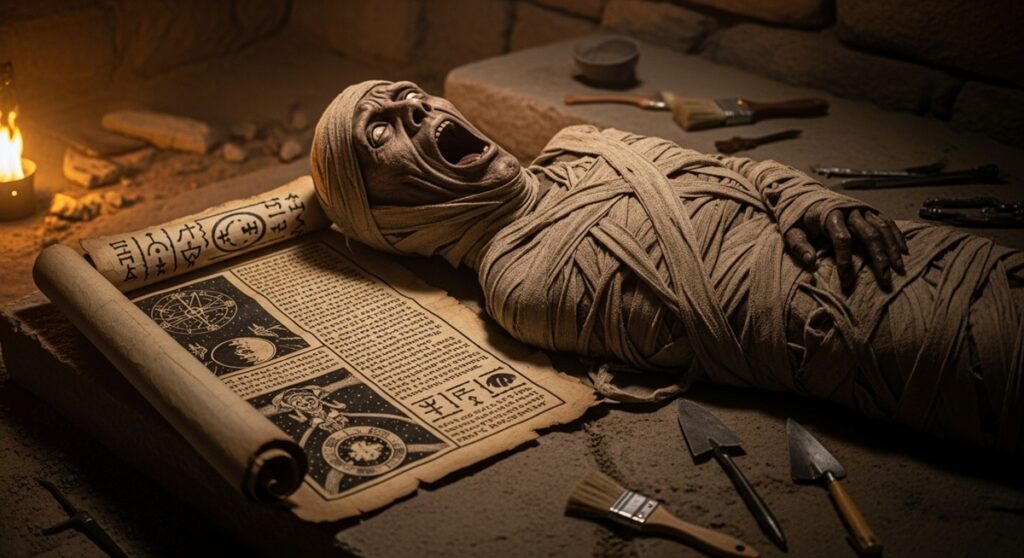
The identity of the mummy remains a mystery. Was it a priest, tasked with guarding the manuscript’s secrets? A prophet cursed for revealing forbidden knowledge? Or simply a victim of a gruesome fate, their final moments etched into their expression? The mummy’s contorted face suggests a death that was anything but peaceful, hinting at a connection to the manuscript’s dire warnings. Some speculate that the individual died in the act of conveying the prophecy, their scream a testament to the horrors they foresaw.
A Symbol of Fear
The Screaming Mummy has captured the public’s imagination, fueling speculation about its role in the discovery. Its grotesque appearance serves as a stark reminder of the stakes involved—not just for the individual buried with the manuscript, but for all of humanity. The image of a figure frozen in terror is a powerful metaphor for the manuscript’s message: knowledge can be both a gift and a curse.
An Archaeological Explosion for Science
The discovery of the Doomsday Manuscript has the potential to rewrite history. If fully deciphered, it could challenge our understanding of ancient Egyptian culture, revealing a civilization that possessed not just technological prowess but a profound philosophical grasp of existence. The manuscript’s warnings about cyclical time and cosmic forces suggest a worldview that anticipates modern scientific concepts like entropy or the cyclical nature of ecosystems.
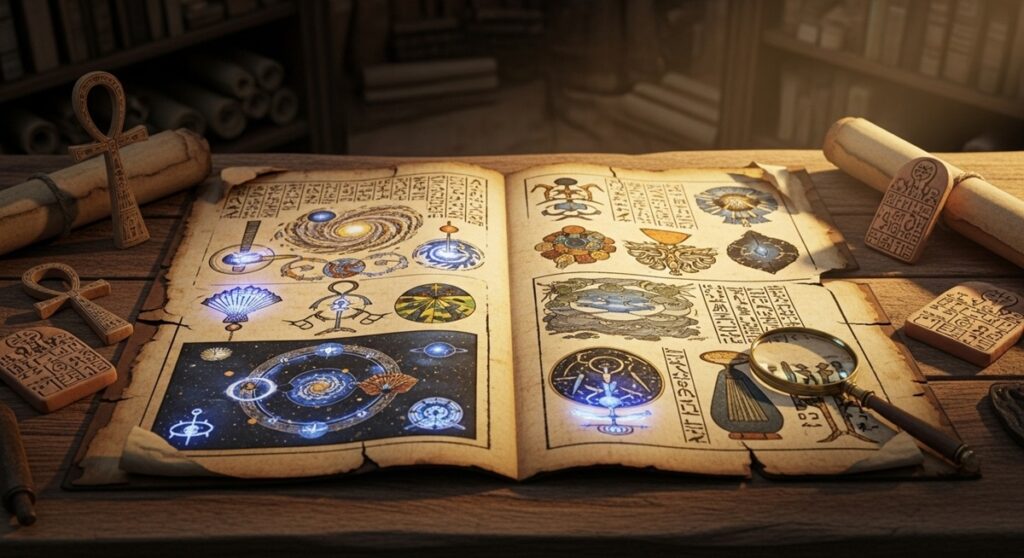
A New Philosophy of Existence
Beyond its historical significance, the manuscript could reshape the philosophy of human existence. It raises questions about free will, destiny, and our responsibility to the past. If the text is correct, humanity is not the master of its fate but a participant in a larger cosmic drama, one where every choice reverberates through time. This perspective could inspire a renewed appreciation for ancient wisdom, urging us to look backward as we navigate an uncertain future.
The Role of Technology in Unlocking the Past
The use of AI and imaging technologies to decipher the manuscript highlights the intersection of ancient knowledge and modern innovation. These tools have allowed researchers to peer into the past with unprecedented clarity, revealing details that would have been lost to earlier generations. Yet, they also underscore the manuscript’s warning: technology, like all human endeavors, must be guided by wisdom, lest it lead to ruin.



